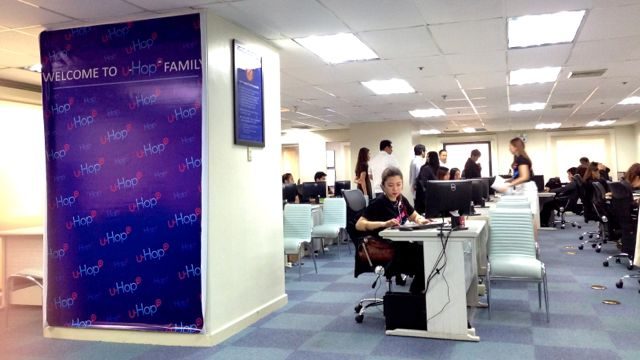SUMMARY
This is AI generated summarization, which may have errors. For context, always refer to the full article.

MANILA, Philippines – A new ride-sharing service plans to combine mass transport with the convenience of using technology and apps to book rides.
U-Hop, a Filipino-developed service established last July, is similar to existing app-based transportation services like Uber and GrabCar. But unlike these two services where one car is deployed to every passenger who requests for it, U-Hop sends shuttles that can seat up to 7 people at a time.
This means more passengers are transported around the metro using fewer vehicles.
“We are not putting more vehicles on the road. We are maximizing the existing number of vehicles, so we won’t add to the worsening traffic,” U-Hop interim CEO Marvin dela Cruz said on Wednesday, September 2.
U-Hop has applied for accreditation as a transportation network company (TNC) in order to operate legally under the new rules set by the Land Transportation Franchising and Regulatory Board (LTFRB).
Once granted, the company can begin registering its partner vehicles and starting operations in Metro Manila, Bulacan, Rizal, Laguna, and Metro Cebu.
How it works
On Wednesday, the LTFRB visited the U-Hop headquarters, where officials showed a demo of U-Hop’s control center and how the system works.
To book a ride, passengers must first register with the system and download a mobile app. They pay fares in advance: roundtrip rides cost P693 weekly, while a monthly roundtrip pass costs P2,970.
Unlimited weekly rides cost P1,400, while a monthly unlimited ride pass costs P6,000.
Using the app, registered members can choose a pick-up point, time, and destination. The system will then generate a route to pick up the passengers and bring them to their destination.
Dela Cruz said U-Hop would be useful for employees and students, who need reliable transport services to pick them up from their homes and drop them off at their offices or schools.
“Some employees come from a particular area in Metro Manila. Why don’t they just share a vehicle to go to work? That’s what we’re targeting. They are heading to one destination anyway, so it would be practical for them to share a shuttle,” he said.
LTFRB executive director Roberto Cabrera said he supports the company’s model, adding that it will help decongest the busy thoroughfare EDSA.
“The vehicles that U-Hop will use can seat 7 people. My argument is that for every fully occupied van that hits the road, we’re taking out 5 or 6 vehicles from EDSA,” he said.
Cabrera added that he will prepare a recommendation, to be signed by the board’s members, to approve the accreditation of U-Hop.
Control center, security features
What makes U-Hop different from GrabCar and Uber is that the Filipino-developed service identifies “service areas” around Metro Manila and matches the number of available vehicles with the number of passengers needing the service.
“We will balance the operators and the members, so that operators will have enough income for them to make a living,” Dela Cruz said.
Unlike the current transportation setup where jeeps, shuttles, and buses compete with each other for passengers, U-Hop shuttles will share the income generated in a particular service area.
“Let’s say in Pasig, you have 100 operators and 700 passengers a day. Whatever is earned will be shared within the group. You don’t have to fight for passengers. You know your market, you know how many passengers will be needing your service. And from our estimate, they should make enough,” Dela Cruz added.
The service also boasts security features for their passengers. Each registered member is issued a membership card, which will be used to verify their identity every time they ride the shuttles.
Passengers will also be asked to provide school or company IDs and other proofs of identity as an added security measure.
Each vehicle deployed by U-Hop will be monitored through the control center. The system will be able to track the shuttles’ location, speed, and whether or not they are traveling beyond their designated service area.
The control center can even stop the engine of the vehicle in case of emergencies, Dela Cruz said.
During his inspection, Cabrera singled out the control center as one main benefit of the U-Hop system.
“The technology they are using is good because at any time, if there are emergencies, they will be able to turn off the engine. That would focus on the safety of the passengers,” he said. – Rappler.com
Add a comment
How does this make you feel?
There are no comments yet. Add your comment to start the conversation.